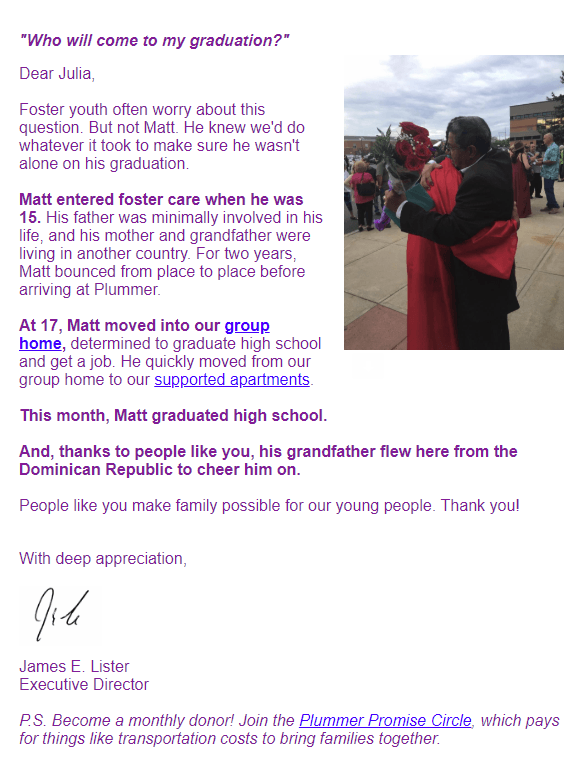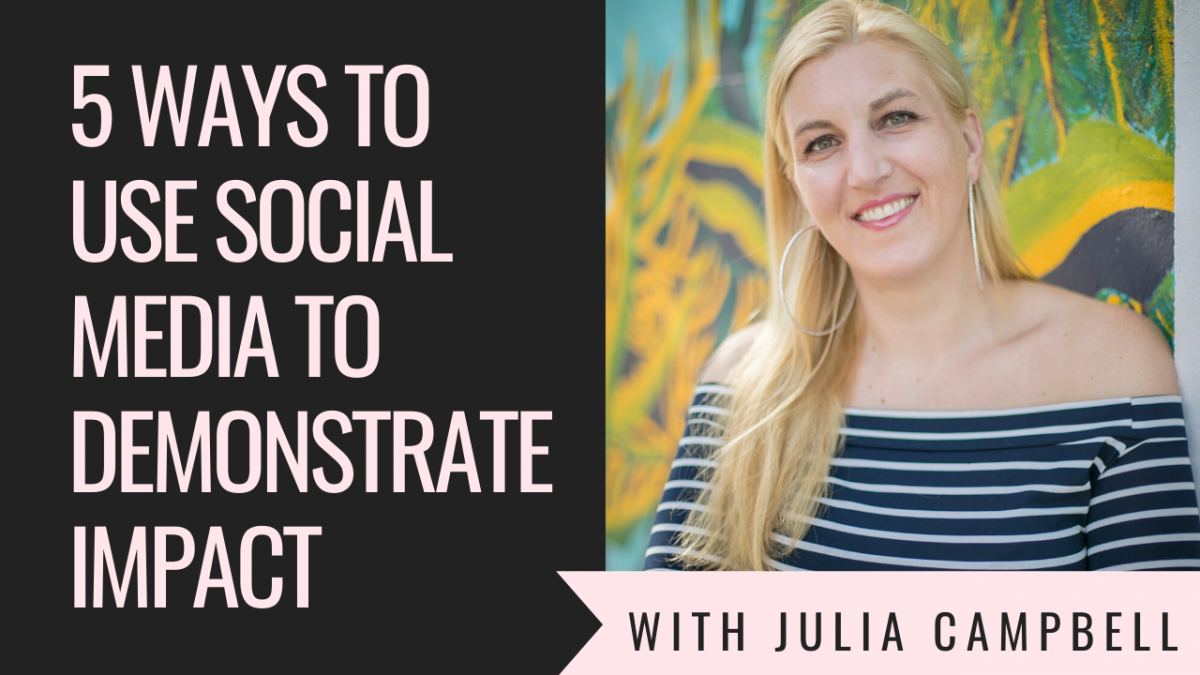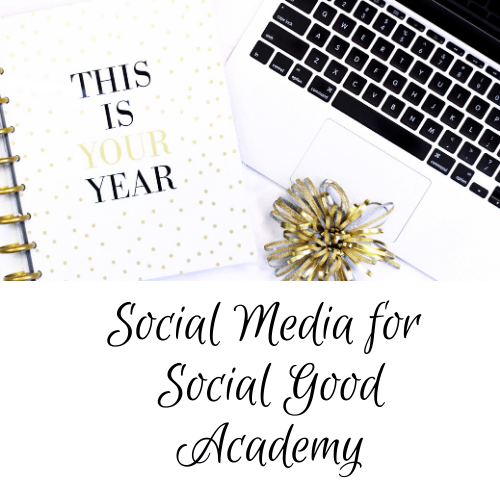Social media provides you with an opportunity to showcase your distinctive and unique footprint on the world.
Your impact is not the “what” of the services you provide – it’s the WHY.
Focus on the benefits you provide, not the nuts and bolts features of the programs.
Even if your organization doesn’t directly serve individuals or animals, you should be able to show some tangible impact of your work in terms that lay people can understand – otherwise, it’s going to be difficult to recruit people into your cause.
Get on the Early Interest List for Social Media for Social Good Academy 2.0!
Created for busy nonprofit social media managers, just like you!
Here are five ways to use social media to demonstrate your impact.
1) Tell evocative stories.
The absolute best way to reach hearts and minds and to convince people of your impact is through sharing stories of transformation and change.
To provide the most agency to the people you serve and to avoid exploitation, these stories are best told by individuals or small groups in their own words, with little to no editing.
Sharing the stories of those that benefit from your work is a perfect way to show stakeholders the direct result of their support.
Storytelling makes complex issues more tangible to audiences that aren’t inside the work every single day.
Filmed in Nepal, Chuna shares her experiences of being a girl in a traditional culture that would not let her get an education.
But she still wanted to learn, and the READ center helped her accomplish this lifelong dream. Her story is one of ambition and transformation, as she now wants to help other illiterate women in her community learn to read.
“I got my daughter back,” says Mia’s mother.
Mia came to Rise Academy in the fifth grade significantly behind, but rediscovered her confidence and skipped four grade levels in reading in one year.
The story of Mia and her mother, and how Rise Academy helped get Mia back on track in school and in her family relationships, is a perfect example of evocative storytelling to showcase transformation and impact.
What parent or caregiver wouldn’t tear up listening to this very relatable story?
2) Use data visualization.
Showcasing impact can come in many forms, not just in emotional videos or photos of the people that you serve.
Nonprofits can create a visually interesting annual impact report and share them across social media platforms, in an email, and on their websites.
Girls Who Code creates and shares multimedia annual reports on their website.
Explore working with a graphic designer or using DIY graphic design tools to create a visual depiction of your annual report that can be shared easily on social media.
Infographics are also popular on social media and a great way to highlight data and make it visually interesting.
3) Gather content from your supporters.
Your online community has a wealth of information and stories at their fingertips.
Your job is to encourage and incentivize them to share publicly to their networks!
Simply asking people to “Share your story!” on social media won’t work – it’s too vague and too overwhelming for busy people who may want to participate but don’t want to tell their entire story online.
Encourage them to participate by showcasing the stories of others like them who have shared photos, videos, and information.
Model best practices and show your audience what you would like them to contribute.
A great example of content generated from your supporters (also called UGC – user-generated content) is the fabulous and powerful #UniteForParkinsons campaign.
Each year on April 11 the world commemorates World Parkinson’s Day to raise awareness of the condition and change attitudes.
The purpose of the campaign was to show what living with Parkinson’s is truly like, so Parkinson’s UK asked people with Parkinson’s all over the world to submit videos ahead of the day.
The two simple instructions that they sent to their followers were to be honest, brave and real and to show that Parkinson’s is much more than just a tremor.
People posted video to give an authentic and powerful insight into their lives.
Best Buddies builds one-to-one friendships between people of similar ages with and without intellectual and developmental disabilities (IDD).
On their social media channels, Best Buddies reshares (with permission) stories, quotes, and intimate moments of the participants in their Friendship Programs, clearly showcasing the impact that the organization has had on both parties involved.
4) Highlight the significance of one project.
For many nonprofits, the issues that they tackle are diverse, complex, and multi-faceted.
Organizations often juggle multiple programs and services, each seeking recognition and promotion on social media.
The result is a jumble of disjointed social media posts that don’t provide an accurate picture of the organization and that confuse and bewilder the audience.
To make it simpler for your social media community to understand, try to highlight the work of one project and the impact that it made.
Take the example of CHOICE Humanitarian, a nonprofit focused on ending extreme poverty in rural areas.
The average person is not likely to understand the complex ways in which development projects contribute to the larger goal of ending poverty.
On their blog and on Facebook, CHOICE shares bite-size pieces of information and short stories about specific projects and individuals to help us understand how the pieces fit together.
Rosie’s Place in Boston provides over a dozen programs and services to their guests, including emergency services, ESL classes, legal services, outreach, mental health care, food assistance, and more.
In order to inspire action on social media, they often highlight just one story related to a single aspect of their work to make their impact more tangible and easy to grasp.
5) Don’t sugarcoat the work.
Yes, you are changing your little corner of the world for good.
You are making a difference and transforming lives, the environment, and the community in positive, powerful ways.
Society is a better place with you in it. But, as we know all too well, the work is hard, treacherous, full of obstacles and minefields.
Not every program succeeds, not every client survives, not every story is tied up in a bow with a happy ending.
If you work in the field of homelessness, or poverty eradication, or social justice, it’s not reasonable or responsible to only show your supporters the success stories.
Life doesn’t usually work out that way, and the majority of your audience knows this.
Don’t sugarcoat or gloss over the hard stuff about what you do to get to those small wins and to create change – we want to see the bumps and bruises that you got along the way.
The St. Baldrick’s Foundation raises money to fund vital cancer research and supportive care for children and families that have experienced a cancer diagnosis.
They share a combination of inspiration and gratitude in their Facebook posts, but they are not afraid to tell their audience about the stark reality of dealing with childhood cancer, and elicit emotions of empathy and sadness to compel people to action.
Plummer Youth Promise, a small foster care nonprofit north of Boston, shares honest and raw stories about what it’s like to find “forever families” for older black males in their program.
They write about the stark realities of the foster care system, writing often with an emotional hook and inviting the audience to consider the questions that the young adults in their program often tackle: “Who would come to my funeral?” and “Who is going to come to my graduation?”



